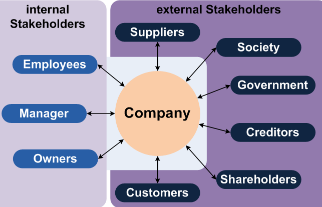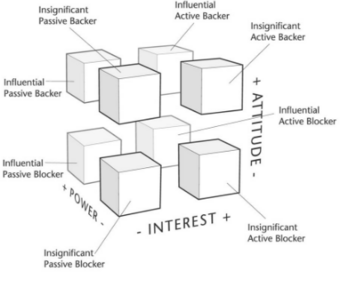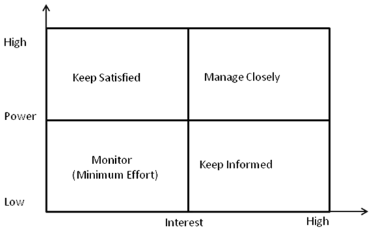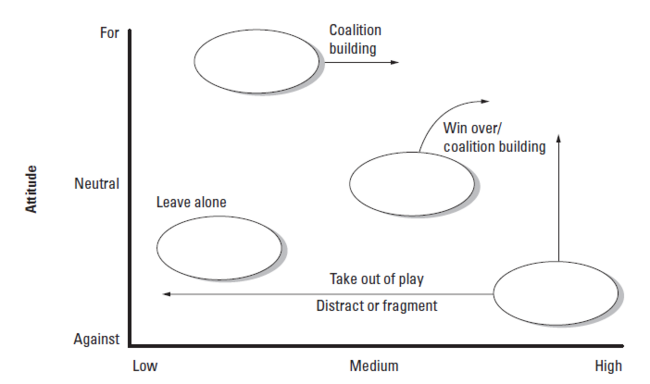Stakeholder Management in Change Programs
Developed by Ioannis Milakas-Tsamouras
Organizational longevity depends now, more than ever, on its ability to adapt to the ever changing environment. Change Initiatives, which consist one of the three major Program categories[1], orchestrate the required adjustments in order for the organization to continue to prosper. One of the main elements that can influence the outcome of a change program, is the stakeholder management during its life cycle. The two major components of stakeholder management are stakeholder analysis and stakeholder engagement. Stakeholder analysis includes the identifying analyzing, mapping and prioritizing of the stakeholders while stakeholder engagement involves the formulation of action plans in order to optimally interact with the most important ones. A variety of tools can be used during the steps of stakeholder management including Grundy’s methodology for influencing stakeholders to support the change program. Despite its importance, stakeholder management faces various limitations including the fact that stakeholder analysis is essentially a snapshot of an evolving environment thus it needs to be constantly updated during the program's life cycle in order to continue to be accurate.
Contents |
Importance of stakeholders in change programs
Organizational change initiatives are programs, that aim to provide benefit for the organization by helping it adapt, in order to survive and prosper in the ever-changing environment. Those programs can either be a result of anticipating change in the environment, where the organization acts proactively in order to be prepared or a reactive response to a clear and pressing need[2] . The intensity of these programs varies from incremental ones that involve small changes and fine-tuning of existing operations, to complete transformations of the organization. Despite the fact that change programs vary highly between each other they all share the attribute that, to some extent, they alter the status quo of the organization. Thus, organizational change programs can be perceived by groups or individuals as an opportunity to disrupt the existing internal or inter-organizational balance of power. Those individuals that can affect or be affected by the change program are called stakeholders. Stakeholders can react in various ways during the lifespan of a change program. Some examples include:
- Members of the organization capitalize on the program as way to obtain power.
- Members of the organization resist the change process because it reduces their power.
- Outsider groups that don’t support the program restrain critical resources from the organization in order to undermine the success of the initiative.
Consequently it is clear that stakeholder management can play a big part on the success of a change program. Various structured approaches to stakeholder management have been proposed such as the “Five-Step Approach to Stakeholder Engagement” by BSR [3] . However, all those approaches share the fact that they include Stakeholder Analysis and Stakeholder engagement as major parts of their method.
Stakeholder Analysis
Stakeholder analysis typically involves the following four steps[3]:
- Identifying: Listing the individuals or groups that can be affected by and/or affect the change program.
- Analyzing: Formulating an understanding of the stakeholders, regarding their point of view, ambitions, power etc.
- Mapping: Visualizing the results of the previous step.
- Prioritizing: Ranking the relevance/importance of stakeholders in order to decide with which to engage.
Identifying

The objective of the first step is to produce a list of the stakeholders relevant to the organizational change program. Various tools and methods can be used on this stage such as:
- Brain Storming: Where people are asked to write down any individuals/groups that come to mind as relevant and then the results are gathered and sorted.
- Mind Mapping: A visualization technique used to organize information. A mind map is hierarchical and illustrates the relationships between pieces of the whole. Broad categories can be used as a starting point such as the OGC stakeholder categories [4] (users/beneficiaries, governance, influencers & provider) and be expanded until a list of stakeholders is composed
- Experience from previous projects/program: Utilize a stakeholder analysis that have been conducted during a previous project/ program. However, this should be performed with caution since the dynamics of stakeholders can change over time and also because stakeholders that are relevant considering one project/program are not necessarily relevant regarding another.
- Organizational charts: These can be especially helpful for identifying the internal stakeholders i.e. those entities within the organization
Analyzing
Once the list of stakeholders has been conducted, the next step involves further analysis of each stakeholder in order to determine their relation to the change program, the links between each other as well as their importance, based on a chosen set of criteria. Multiple criteria have been proposed and being used in practice and their selection depends on the specific case and the background of the people conducting the analysis. Some of the most common criteria are[2]:
- Support towards the change program (attitude)
- Ability to influence the outcome of the change program (power)
- Awareness regarding the change program
- Interest towards the change program
- Willingness to engage
- Necessity of involvement
- Position in the information flow network.
Mapping

The mapping stage aims to provide a better understanding of the relative importance of stakeholders by visualizing the relative position of the stakeholders based on some or all of the criteria used previously on the analysis phase. Usually mapping is two dimensional with each axis representing a criterion. However three dimensional mapping is also possible with the size/color/shape of the depiction of the stakeholders representing the third dimension. Frequently use stakeholder mapping tools are:
- Power/Influence- Interest grid
- Power/Influence – Impact grid
- Three-dimensional grouping of power, interest and attitude [5]
Prioritizing
As it is not practical and usually unnecessary to engage with all stakeholder groups with the same level of intensity it is important to prioritize them in order allocate the most time and effort to the most important ones. The analysis and mapping steps, if performed correctly, would lead to a shorted list of stakeholders based on a set of criteria. Furthermore groups of stakeholders can be formed at this stage that require the same form of engagement. Finally the importance of the selection of the right set of criteria at a given time should also be stressed.
Stakeholder engagement
Once the stakeholders have been identified, analyzed and prioritized the next step is the formulation strategies and action plans in order to optimally engage with them. The level of engagement as well as the choice of strategy, depends on how important each stakeholder is for the success of the change program. Considering that four “high level” strategies for managing stakeholder can be identified [6] [7]:
- Being Proactive: actively engaging with stakeholders and trying to resolve any issues they might face
- Accommodating: trying to deal with stakeholder issues without engaging as actively as in the proactive strategy
- Defending: doing the minimum in order to accommodate the stakeholder issues
- Ignoring: or refusing to address the stakeholder issues because they are considered as unimportant for the success of the program

Stakeholder mapping is also utilized in order to decide on engagement strategies. Perhaps, the most widely used application of a stakeholder mapping tool deploys the power/influence – interest grid and categorizes the stakeholders in the following four groups with their respective engagement strategies[8]:
- High Power High Interest: Those stakeholders are the “key players” thus they should be a top priority and managed closely. If an organization falls into this category possible beneficial engagement tactics could include some sort of partnership or collaboration.
- High Power Low Interest: The stakeholders that fall on this category should be kept satisfied and their need should be attended because, even though they have low interest on the change program, they have the power to influence its outcome.
- Low Power High Interest: Those stakeholders have low power to influence the change program individually. However it is best to be kept informed about the developments and their attitude towards the program should be monitored since they could form coalitions with enough power to influence the program.
- Low Power Low Interest: The organization should spent minimum effort and time regarding the engagement with the stakeholders of this category. Nevertheless those stakeholders should be monitored in case their level of influence or interest changes or in case a powerful coalition arises from them.
Another important stakeholder category that needs to be considered are individuals that hold important positions on the information flow network of the organization. Those individuals don't necessarily have high power or interest regarding the change program but they can play an important role in the spreading of important information regarding the change program through the organizational network or as gatekeepers of information who filter, alter or withhold it. Therefore, engagement with those individuals is necessary in order to achieve the desired information flow through the organization during the change program. [2] [9]
Actions for influencing stakeholders to support the change program
John Heyes[2] based on a stakeholder analysis process developed by Tony Grundy [10] proposed a list of actions that could help the change program obtain the maximum level of support. Grundy mapped the stakeholders on two dimensions based on their power to influence the change program (high, low) and their attitude towards the change (positive, negative). Once the stakeholder analysis based on these criteria is performed, the following actions could take place.
- Gaining the support of stakeholders that have negative attitude towards the change but have high power to influence the program. This could be managed by involving them more in the change process, bargaining with them or provide them with information that could persuade them about the necessity of the program. It is important for the program manager to try and understand the point of view of those who oppose the change and even giving the skeptics an opportunity to express and discuss their thoughts could lessen their negative attitude and prevent firm opposition due to stubbornness.
- Increasing the influence of the supporters. In order to achieve this a program manager could try to allocate supporters on positions with high power, or in decision making groups. As a result individuals with a positive attitude towards the change program would be able to materialize their support through actions aided by the power of their organizational position.
- Reducing the influence of powerful stakeholders who oppose the change. This can be achieved by preventing individuals from being part of decision making groups regarding the change program or if possible transfer them to another part of an organization. Moreover they can challenge their arguments or openly counter-argue their criticism.
- Forming coalitions of stakeholders who support the change. Even though a stakeholder can have small influence as one entity a group of stakeholders working together could have a strong impact. A program manager can influence the formation of such coalitions by successfully communicating the vision of the change program and highlight the mutual benefits that individual stakeholders would achieve by working together towards the implementation of the change.
- Breaking apart existing coalitions which oppose the change or preventing their formation. This might be achieved by turning key players of the coalition into supporters as discussed on the first action.
- Introducing new powerful supporters. The program manager can try to persuade powerful stakeholders that have a neutral or indifferent attitude towards the change to embrace and support it. This can be achieved by publicizing the change process so it would reach stakeholders outside the organization.
- Re-framing the change program in a way that attracts more supporters. If the stakeholder analysis shows that the opposition to the program is much higher than the support, it might be necessary for the program to be re-framed in such way that accommodates the needs and wishes of important stakeholders in order to attract the necessary support and be successful.

Limitations
One of the main limitations of stakeholder analysis is that it provides a snapshot of a dynamic field. Relationships between stakeholders as when as their power interest and attitude are subject to change through the life cycle of the change program. As a result stakeholder analysis should be constantly revisited and updated. Moreover, caution should be exercised when results of older stakeholder analysis are deployed during the process of a newer one. Furthermore, the success and objectivity of the analysis depends heavily on the position and background of the persons who conduct it. For example if the analysis is made by external consultants it might be more objective regarding external stakeholders but lack insight on the internal ones. On the contrary an analysis conducted by members of the organization could be really detailed concerning the internal stakeholders but prone to subjectivity due to personal views or emotions. Other limitations of the stakeholder analysis lie on assessing the stakeholders based on the chosen criteria. Firstly, most of the commonly used criteria are qualitative and no quantitative. Thus they can not be measured objectively and can only give a taxonomy based on the relative "results" between the stakeholders. Moreover certain stakeholders could have high power to influence a certain side of the change program and low on others. Finally stakeholders might have hidden agendas, making the assessment of their interest for the program hard.
Further Reading
- Stakeholder Management
- Stakeholder Analysis
- Stakeholder Analysis Process
- Stakeholders from a dynamic and network perspective
- Managing communication through Network mapping
- The relevance of management organizational change
- The Role of Program Management in an Organisational Change
Annotated Bibliography
- The Theory and practice of change management Hayes, John: A comprehensive book on change management, covering all aspects of the change processes from recognizing the need of change, diagnosing what needs to be change and planning the change process to implementing the change program and sustaining the change. It Includes both scholarly discussion and practical application.
- Back to Basics: How to Make Stakeholder Engagement Meaningful for Your Company, Morris, Jonathan & Baddache, Farid: An analysis of BSR's five step approach to stakeholder management. It includes separate reviewing of each step: Engagement Strategy, Stakeholder Mapping, Preparation, Engagement & Action Plan.
- Understanding programs and Program Management,UK Office of Government Commerce, Department for Business Innovation and Skills: A guide for those involved in delivering large-scale programs in BIS and its partner organisations. It aims to present the basics of programs and program management and highlight the ways they differ from projects and project management.
- Making Sense of Stakeholder Mapping,Ruth Murray-Webster & Peter Simon: This paper introduces the three dimensional grid of power, interest and attitude as a tool for stakeholder analysis.
- Strategy Implementation Through Project Management Grundy Tony: A guide through Managing strategic projects. linking projects with business strategy,strategic project definition,project strategy & plans and strategic project control and learning. It includes an analysis of engagement tactics in order to win the support of stakeholders.
References
- ↑ Oehmen, Josef Introduction to Program Management (Part 1), DTU 42433: Advanced Engineering Project, Program and Portfolio Management,Lecture Slides.
- ↑ 2.0 2.1 2.2 2.3 Hayes, John The Theory and practice of change management, Palgrave Macmillan, 4th edition, 2014.
- ↑ 3.0 3.1 Morris, Jonathan & Baddache, Farid Back to Basics: How to Make Stakeholder Engagement Meaningful for Your Company" Cited 20.09.2016,https://www.bsr.org/reports/BSR_Five-Step_Guide_to_Stakeholder_Engagement.pdf
- ↑ UK Office of Government Commerce, Department for Business Innovation and Skills Understanding programs and Program Management", 2010 Cited 18.09.2016,https://www.gov.uk/government/uploads/system/uploads/attachment_data/file/31978/10-1256-guidelines-for-programme-management.pdf
- ↑ Ruth Murray-Webster & Peter Simon Making Sense of Stakeholder Mapping ", Published in PM World Today - November 2006 (Vol. VIII, Issue 11) "Connecting the World of Project Management,Cited 10.09.2016,\http://iptk.gov.my/doc/Making%20Sense%20of%20Stakeholder%20Mapping.pdf
- ↑ Carrol, Archie A three-dimensional conceptual model of corporate performance,Academy of Management Review, 4(4) 497-505.
- ↑ Clarckson, Max A Stakeholder Framework for Analyzing and Evaluating Corporate Social Performance,The Academy of Management Review, 20(1), 92-117.
- ↑ Mitchell, R. K., B. R. Agle, and D.J. Wood Toward a Theory of Stakeholder Identification and Salience: Defining the Principle of Who and What really Counts,Academy of Management Review 22(4): 853 - 888.
- ↑ Social network analysis,Wikipedia https://en.wikipedia.org/wiki/Stakeholder_analysis
- ↑ 10.0 10.1 Grundy, Tony Strategy Implementation Through Project Management, Thorogood, 2001.